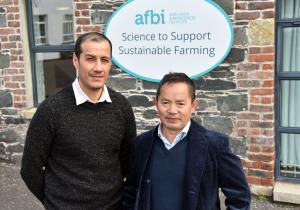Substantially reducing the carbon footprint of a dairy farm is achievable
Date published:
Reducing the carbon footprint of dairy farms is achievable however a range of tools will be needed to effect change, including the use of feed additives such as seaweed extracts, reduced use of nitrogen fertiliser and more efficient management of animals, a leading agricultural scientist has said.

Dr Tianhai Yan, a world leading scientist at the Agri-Food and Biosciences Institute, specialising in methane emissions from cattle, was addressing the key findings of the recent Centre for Innovation and Excellence in Livestock (CIEL) report ‘Net Zero and Livestock: How Farmers Can Reduce Emissions’.
Using real case study farms, the report highlighted that by deploying a wide range of mitigation measures a 31.5% reduction of the carbon footprint of a higher yielding herd was achievable, while a 16.9% reduction was possible with a spring calving herd.
Dr Yan began, “There are a range of practical mitigations that can be used on dairy farms to help ensure that emissions from agriculture can be reduced, this includes practical nutrition and management-based practices designed to lower emissions of ammonia and methane.”
“At AFBI, we have conducted extensive research modelling mitigation strategies on our farm to help determine the most effective way to reduce greenhouse gas emissions (GHG) from cattle and sheep. This includes the development of energy rationing systems for precision farming which have resulted in improvements in the efficiency of milk production and has reduced the GHG emissions per unit of milk produced.”
“We are also researching the nutritional benefits of alternative forages for dairy and beef cattle including measuring how this forage as well as feed additives and seaweed extracts can minimise the impact of enteric methane emissions from the herd.
“This combined with management practices such as reducing the age at first calving to 24 months, improved genetics and fertility has shown that a significant reduction in GHG emissions can be achieved.
“The research outlined in the CIEL Report is a fantastic resource for all livestock farmers and I’d urge them to take some time and study its findings,” he concluded.
The report sets out eight options for farmers that if implemented partly or wholly could help make a significant difference to the emissions from the dairy sector.
Lead on the research, Professor Elizabeth Magowan, also highlighted that the range of mitigations modelled in the report could not only help protect the environment, they could also help farms become more efficient.
Professor Magowan said: “In our research we have identified a number of key areas where farmers could act now to reduce their carbon footprint. One of those key areas is around efficiency on the farm. Improving efficiency not only reduces the carbon footprint of farms, but it also helps ensure farms are better run and more profitable.”
Dairy Industry
The dairy industry plays a significant role in Northern Ireland’s agricultural economy with the milk produced in 2020 valued at more than £660m. The sector has been working hard to reduce GHG emissions in recent years with total emissions having fallen by 16.1 percent between 1990 and 2020, something achieved by increasing production per cow and reducing the overall herd.
The dairy industry primarily contributes to GHG emissions with methane and nitrous oxide the primary gases released into the atmosphere from dairy systems. The report outlines a range of mitigation measures that will deliver greater efficiency on the farm and reduce emissions.
Research
Central to ensuring successful mitigation is measurement. The report advises that farmers should complete regular carbon audits of their farm to establish a baseline and to identify areas where they can reduce emissions and their carbon footprint. Using a reliable carbon calculator is recommended to assist farmers establish how their practice can be amended to benefit the environment. Reliable carbon calculators should use underlying assumptions aligned with IPPC methodology which represent the core methodology used within inventory accounting.
Among the nutrition-based strategies suggested are increasing the starch and concentrate proportions in the diet of cattle, within recommended levels, to reduce methane production per unit of feed. This strategy could also increase milk output in some circumstances. Furthermore, locally sourced products such as peas and beans, will also reduce the carbon footprint of farms, especially if they replace soya which was grown in areas where deforestation has taken place.
The report also encourages farmers to improve the quality and utilisation of forage as a major component of the cow’s diets and to reduce the need for artificial fertilisers while maintaining or enhancing sward productivity. This can be done by including legumes, such as clover, in pastures and promoting soil health and fertility.
Management-based strategies that may be adopted by farmers include reviewing how slurry or manure is stored and applied. Among the options available to farmers are adding additives to reduce emissions from stored manure, precision application of manure and fertiliser and low emission spreading which reduces the ammonia and nitrous oxide emissions while improving nitrogen efficiency.
The modelling demonstrates that by increasing the efficiency of the dairy herd, land could be freed up and this land could be used for afforestation, which in turn will help sequester more carbon from the atmosphere and further reduce the carbon footprint of the farm.
The CIEL report provides more details on many of these mitigation measures and their impact. Furthermore, the AFBI research programme continues to develop and measure the effectiveness of a wide range of options to reduce the environmental impact of dairy farming.